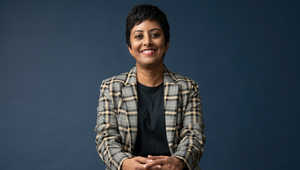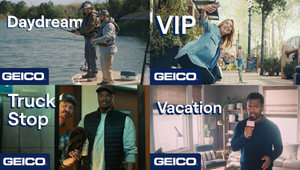
Is This Robotic Camera the Answer for Socially Distanced Production Teams?

To varying degrees across the world, live action film production is beginning to make a comeback. But things are far from what they once were. Crews might not feel comfortable to travel yet and even if they are, there are limitations as to how many of them are allowed on a set. Likewise, there are similar issues when it comes to the talent in front of the camera.
In a bid to quash the effects of social distancing on production, a cinematographer and executive producer / talent manager, both based in LA, have launched SOLO Cinebot. Founded by Josh Shadid of production studio Lord Danger, and Aaron Grasso of Antagonist Camera, a boutique camera rental shop in LA, SOLO Cinebot is a robotic camera that meets the needs for an array of companies including brand marketers, production companies and ad agencies, as well as remote talent. It is zero-touch for talent and gives full control for crews via networked controls that offer tactile, real-time joystick camera operation over pan, tilt, zoom, image settings, camera height, audio monitoring and more. No experience is required to use it - simply plug it in and you’re ready to roll. Additionally, it offers real-time communications and video monitoring via private virtual 'Green Rooms' to help talent prepare and receive direction.
Addison Capper chatted with Josh and Aaron to find out more about the invention that could be the solution to your production problems.
LBB> What are the foundations of Solo Cinebot? When did this idea first come to you and what were the starting points of making it a reality? Was it before the pandemic or a reaction to it?
Josh> SOLO was a reaction to the pandemic. Whenever there is a major shift in societal behaviour there are always indirect opportunities. I refer to this as ‘selling shovels’, a reference to how in the gold rush most of those who were actually successful sold ‘shovels’, (supplies used for gold mining). Throughout the first week of back to back Zoom calls with my team, I continued to ask the question - look around you, it may feel like everything is broken, but there are opportunities everywhere. What are the shovels? I had a glimpse of an idea for a fully remote camera solution and picked up the phone to call Aaron who took that fragment of a thought, saw the potential for what it could be, and immediately began ideating on how we could make it a reality. We were fortunate to have a full camera house, two pretty insane workaholics with nothing to do, as well as a list of potential clients to consult with to fully grasp the variety and magnitude of needs. In the first week Aaron had ripped apart his shop and built a functioning V1 prototype - I think that was like March 30th. Since then we’ve stripped it apart four times, rebuilding it from the ground up to solve the problems we discovered along the way.
Aaron> I own a camera rental house in Los Angeles and I, like almost everyone else, found myself having to close up shop with no new work in sight. We’re a pretty new business and just built out our first real location so I had a bit of a freak out at first, but I quickly started brainstorming ways to utilise all the gear we had to make a safe and contactless working environment on our stage upstairs. When Josh came to me he told me that his clients were still looking for ways to get messaging out, and if I had any ideas on what we could do. It was great news for me because it was the only prospect of work at the time, plus I always love a good challenge. It was kind of a perfect storm. I suddenly had a lot of free time on my hands, a giant (empty) workshop, and everything to lose.
My 1st assistant cameraman and good friend, Keith Jones, was one of my first calls and to my luck, he was also recently unemployed! He is a total nut and super tech-savvy. We’ve built some pretty crazy camera rigs together before so this kind of thing seemed right up our alley. We built the first working iteration in a few days, but once we realised how much more in-depth we could get we basically started working around the clock for weeks on end, just going down a rabbit hole of possibilities. I assumed there would be a lot of remote systems popping up, so it was super important to me that we made something that was really awesome - not only completely turn-key and easy for talent, but also gave us filmmakers the tools we need to capture footage like we would if we were there in person. I feel like we opened Pandora’s box.
LBB> You are a DOP and an EP - who did you work with on the tech aspect of this camera? And what kind of technology is powering the camera?
Josh> We are fortunate to have a lot of really smart (and thankfully, nerdy) friends. We called on a few people along the way, foremost Keith Jones, who’s been working tirelessly, ideating, building, designing and running tests on the machines since the first day Aaron and I began. Secondly, we called upon our friends at LA Drones, who have a long track record of strapping cameras to computers and flying them around the sky. This seemed like a good place to start. Their engineers were able to jump in where our technical knowledge ended, and dive into some of the more specific engineering and networking challenges.
Aaron> Honestly, we are very fortunate to be in an era of film that utilises so much awesome technology. I knew right away something like this was possible, we just needed the right combination of parts to make it all do what we wanted. We had the first iteration of a remote system with a great camera built pretty fast, but once that happened we started discovering all of the limitations of remote filming. Our primary focus then became on increasing efficiency, improving user experience for both talent and technicians, communication, and really just trying our best to recreate as the experience we would expect on set. This tall order brought us into a whole world of advanced networking and IP which was pretty foreign to us. Fortunately, our good friends at LA Drones were available to help with a lot of that stuff and we could focus on what specific functions we needed to achieve in order to make the system robust and dependable.
To answer the last part of your question, there are many technologies combined that go into making the SOLO Cinebot so special - everything from high-quality cinema tech to basic video chat interfaces, virtual walkie talkies to programmed robotic lifts, and of course a whole lot of IP control.
LBB> Can you give us an overview of how this works? How is the camera controlled? How much crew do you need to utilise the camera?
Josh> Oh yeah, this is the fun part. So honestly, you really only NEED one person - depending on the requirements of the shoot, they can even run multiple cameras. But we built it with the flexibility for multiple operators to run each of its systems independently as well. So, if you need dynamic movement on multiple cameras simultaneously, with lighting cues and a tough sound landscape that needs a constant monitor - you’re able to assign one person to each of these controls. The best part is, they can all be in different locations, communicating on ‘virtual walkies’ just like they’re on set.
The camera can be controlled several ways, but our favourite is through a hardware controller. This gives low latency operation of all the camera’s functions, with a familiar joystick control. Additionally you can use the GUI (graphical user interface) to control all the camera settings and movements over a standard internet browser with a regular old mouse.

LBB> So much of a DOP's role is being in the moment to get the perfect shot and lighting. How is this possible with Solo Cinebot?
Josh> I should let Aaron answer that, but I will add something as I was harping on about the fact that the set up needed to be simple. “ONE BUTTON - no more than ONE BUTTON” was annoyingly repeated throughout each design stage. Aaron was equally insistent that he needed to have as much control as possible over every aspect of the film set. If that wasn’t possible, then, as a DP, he’d not want to use it.
Aaron> Wow, there is so much to consider here I could write you a novel but I’ll do my best to summarise. Image quality largely comes down to camera choice, resolution, lensing, colour science, angles and, of course, lighting. The hardware we put into our units gives us an impressive balance of beautiful image quality and versatility for a massive range of applications. It was super important to me that our XT unit had adjustable height control. It allows for so much creative freedom and control over your angles that a cinematographer really needs to do their job well. I think that is what really sets our product apart from anything else out there.
Another major consideration as both a DP and camera operator is the ability to monitor what it is you’re recording with accuracy and be able to react accordingly. For instance, if there is flickering from a low-quality fluorescent light somewhere in a talent's home, I would be devastated to find out after the fact that the footage I recorded was flickering the whole time but we couldn’t perceive it over the connection. It is imperative that we have an ultra-low latency, high-resolution monitoring solution so we can see fine details and accurate colour renderings, as well as low latency so we can operate the camera reliably. This was perhaps the most challenging and time-consuming aspect to this whole endeavor, but our networking team did such an incredible job with some pretty major demands, and where we ultimately landed was well worth the time spent on it.
LBB> When building the camera, what were the main things you had to consider when it came to ensuring that a production could happen as fluidly as possible when using it?
Josh and Aaron> 1. No talent set-up required.
2. Fully independent IP control over camera, lighting, and audio
3. Low Latency monitoring and video communication
4. Low Latency camera operations
5. Backchannel crew communications
6. Ensuring that we create new skilled job opportunities for our talented friends and family who work in the industry.
LBB> How can Solo Cinebot aid productions during this period of social distancing?
Josh> Several ways. Firstly, we can now send a remote-controlled, zero set up, Netflix approved, cinema-quality camera to anywhere you need it - operating them from wherever you are. This helps us rethink what’s possible in social distancing and beyond.
We have also developed our third product, the Solo Connect. This device allows traditional sets to provide real-time monitoring and communications for clients, directors and collaborators. We are required to reduce our set size and the Connect creates a virtual video village so anyone who needs to be involved, can be - without having to huddle around a monitor in a van somewhere.
LBB> How can you see it being utilised once the world is able to travel and gather freely again?
Josh> I very much look forward to that day, as I know we all do, but I don’t think it’s going to simply ‘go back to normal’ right away, or ever. I recall stories of grandparents who had survived the Great Depression and still kept shoeboxes of money under the bed. They never trusted the banks again. This massive global event will leave a scar on a generation, and I believe the way we approach some aspects of filmmaking will change along with that. Do celebrities and CEOs really want a production crew in their house to conduct an interview? Does anyone really enjoy going on press tours to market their films? I think there are multiple stages to our recovery but we’ll find in this future that new innovations will expand what we accept as, and consider, ‘normal’.
LBB> From a broader perspective, how do you see the long term implications of the pandemic on the production industry?
Josh> I look to the changes that are already occurring in the corporate world. CFOs are realising the massive cost savings that can be reappropriated from the current ‘workspace’ as our comfort with remote work and its efficiencies are evolving in real-time. I look at the travel budgets within productions, on both the client and the production side, and see how much of that money could be spent on the actual product, instead of the oversight of making it. If we learn that it’s just as effective to remotely work (film, monitor and communicate) as it has been discovered in the workplace, I see no reason to go back to hotels, airplanes, rental cars and per diems when all can be done from the comfort of your own home. It increases productivity, decreases liability and reduces stress.
Also, we see a bright future for working to integrate new robotic technologies into our industry. As we get back to full-scale productions, we see a place for the current SOLO product line, as well as the products we’ve yet to release. If cameras, lights and sound can all be delivered to set in pre-configured cases that can be remotely controlled (even with crews on location, and back to the usual size) we will optimise much of the build / break down process that traditionally takes hours of your shoot day - allowing us to put more money on-screen, and shoot more content in a day.
LBB> What reaction have you seen since launching the product? And how are you educating people on its possibilities and how to use it?
Josh> So far the reactions have been very positive - the most common response I’d say has been, “woah, this is exactly what we are looking for”. Which, y’know, feels pretty good to hear. After our version two product was ready, we started to share some of the capabilities with a few of our friends. Within a few days we were receiving calls from people from all over the industry asking for demos and materials, scheduling shoots and tests, including people we’d never met that ‘heard about it from their friend’. We realised the scale of this whole thing and that we only got one opportunity to make a first impression. So, we went dark mode until we felt the product was ready to share.
Aaron> The amount of interest we were receiving even at the beginning was almost a bit overwhelming, but it’s really become the motivation to keep pushing the design to new heights. I am really excited for the possibilities with SOLO. There is so much you can achieve from wherever you are in the world. I really believe this will open up a world of new opportunities for people in places far and wide. We want SOLO to be a tool that filmmakers around the globe can use to collaborate with one another. I hope this technology can get us all working again - often and safely.















